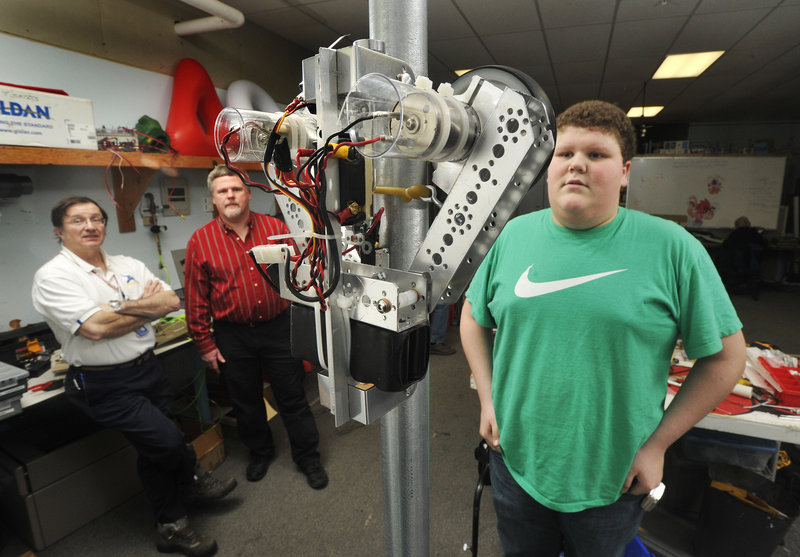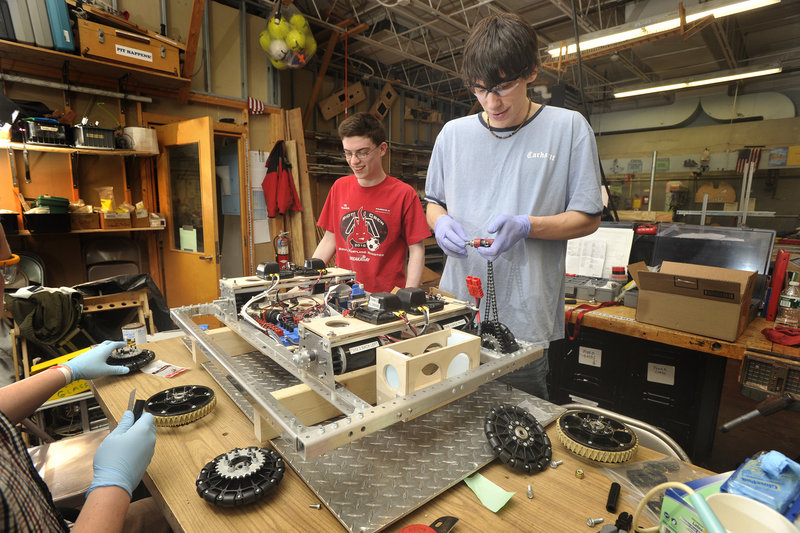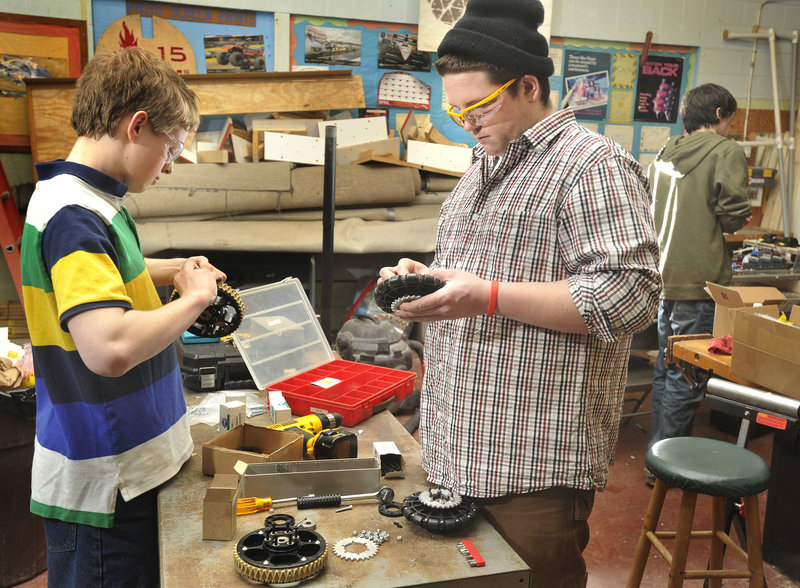Jacub Emery hunched over a careful configuration of wires and wheels and aluminum framing and purred his devotion to the drivetrain taking shape on the worktable in front of him.
“This is my baby,” he said. “This is what I do for hours and hours and hours. If we’ve got it right, it should go about 10 mph, which would be the fastest robot we’ve ever made.”
Emery is a member of the Riot Crew, the FIRST Robotics team at South Portland High School. A junior, Emery joined the team when he was a sixth-grader at Memorial Middle School. He’s one of 30 students on the team, working on everything from project planning and robot construction to website development and video production.
This is “build season” for the Riot Crew, the oldest of eight FIRST Robotics teams across Maine, from The New High School in Kennebunk to Messalonskee High School in Oakland.
It’s an intense two-month period when the teams meet every school night and on weekends to build the robots they will enter in a series of FIRST Robotics competitions in March and April. Working with them are the coaches and adult mentors who appear to get as much out of the experience as the students.
Jim Henningsen became a mentor to the Riot Crew when his son Joe joined the team. His son is in the Army now. Henningsen is still working with the crew.
“I got hooked,” said Henningsen, a food wholesaler. “It opened up a part of my brain that I had shut.”
Other FIRST Robotics teams in Maine represent Falmouth and Gorham high schools, Bonny Eagle High School in Standish, Traip Academy in Kittery, the Sanford Regional Technical Center and the Boys & Girls Clubs of Southern Maine. The last three teams are in their first year of competition.
FIRST Robotics is an international high-school-age competition that was started in the early 1990s by Dean Kamen, a New Hampshire resident who invented the Segway personal transporter, among other things.
This year, more than 2,000 FIRST teams, including about 52,000 high school students, will participate in 58 regional, state and district competitions. They will face off in nine countries, including Australia, Brazil, Canada, Germany, Israel, Mexico, Turkey and the United Kingdom. In the end, 340 teams will advance to the final competition April 27-30 in St. Louis.
Several of the Maine teams, including the Riot Crew, will compete March 3-5 in the BAE Systems FIRST Granite State Regional Competition in Manchester, N.H. Others will attend the WPI FIRST Regional Competition March 10-12 in Worcester, Mass., or the Boston FIRST Regional Competition April 7-9 at Boston University.
The Messalonskee team will compete in all three regional events, as well as a few off-season meets hosted by individual teams.
“We spend an intense six weeks building a robot,” said Jamee Luce, a math and computer teacher and robotics coach at Messalonskee. “Rather than go to just one event, we try to make the most of it.”
Each year, teams are challenged to build robots weighing as much as 120 pounds. This year, each team is building a larger “host-bot” that carries a smaller “mini-bot.”
The robots are guided by wireless controls and can do specific tasks during a game, which changes every year. FIRST Robotics provides game details and two boxes of standard parts in early January.
This year’s game is called Logo Motion. Teams will be challenged to transport and hang the largest number of inflated plastic tubes (like those used in a swimming pool) onto a vertical grid. The tubes are circle-, square- and triangle-shaped, like the FIRST Robotics logo.
Awards will recognize everything from creativity and professionalism to best industrial design and best offensive round.
The teams muster extraordinary commitment and fundraising efforts to participate in competitions that are time-consuming and expensive.
Each team must pay $5,000 to enter a FIRST Robotics regional meet ($6,500 for rookie teams), which doesn’t include transportation, hotel or food costs. Some teams attend several meets in a year, and all hope to attend the international competition, which costs $15,000 to $20,000.
Most FIRST teams have multiple sponsors. Bonny Eagle received $2,500 this year from National Semiconductor in South Portland and works in space provided by TEM Inc. in Buxton.
The fledgling team at the Sanford Regional Technical Center received a $6,500 NASA grant, and the Falmouth-Gorham team is sponsored by Idexx Laboratories. The Messalonskee team is sponsored by the Maine State Credit Union and Wrabacon, which provides a work space and technical assistance.
Recognizing the financial challenges for all FIRST teams, Fairchild Semiconductor decided to increase its support of student robotics this year. The South Portland-based company had been giving the Riot Crew $25,000 each year since 1996, according to coach Bob Libby, a self-employed network engineer.
This year, Fairchild increased its contribution to $65,000 to support all eight FIRST Robotics teams in Maine, as well as the Maine VEX Robotics competitions and FIRST LEGO League meets, said Bob Conrad, a Fairchild vice president and philanthropy committee member. The international company plans to seek other corporate sponsors to help expand robotics for students in Maine.
The third annual Maine VEX Championships were held Saturday at the Bangor Auditorium. Twenty-one teams were to compete in a similar goal-oriented game using smaller robots. Cape Elizabeth, Jay and Portland Arts and Technology high schools each signed up several teams.
“Fairchild needs technically educated people who are creative, innovative and motivated,” said Steve Martin, a Fairchild engineer who has been a mentor to the Riot Crew since 1996. “This experience allows the students to see how engineers work. We go through some of the same processes here that we go through at Fairchild.”
Fans of the robotics programs say they encourage students to pursue careers in science, technology, engineering and math. Martin’s oldest daughter, Julie, joined the Riot Crew in 1996. Now, she’s a biology instructor at a community college in Troy, N.Y. Martin’s daughter Mikaela was a team member, too, and now she’s studying for her doctorate in civil engineering.
But team members and others say you don’t have to love science and math to enjoy robotics. They talk about the excitement of taking on a challenge, working as a team and contributing individual talents to reach a common goal. And they talk about building friendships that often last long after graduation.
“You have to have a fundamental interest in building stuff and working together,” said Ross Usinger, hammering a prototype of the vertical grid that the Riot Crew’s robot will face in competition.
A freshman at Deering High School in Portland, Usinger has been a member of the South Portland team since he was in sixth grade.
“I love these guys,” Usinger said. “They’re like a second family.”
Staff Writer Kelley Bouchard can be contacted at 791-6328 or at:
kbouchard@pressherald.com
Send questions/comments to the editors.





Success. Please wait for the page to reload. If the page does not reload within 5 seconds, please refresh the page.
Enter your email and password to access comments.
Hi, to comment on stories you must . This profile is in addition to your subscription and website login.
Already have a commenting profile? .
Invalid username/password.
Please check your email to confirm and complete your registration.
Only subscribers are eligible to post comments. Please subscribe or login first for digital access. Here’s why.
Use the form below to reset your password. When you've submitted your account email, we will send an email with a reset code.